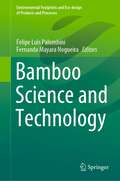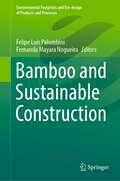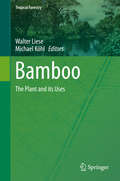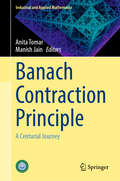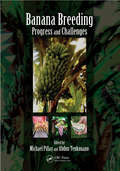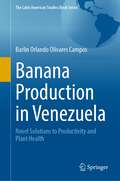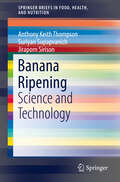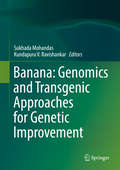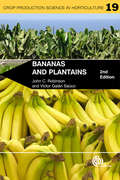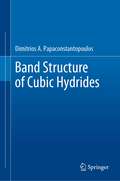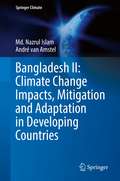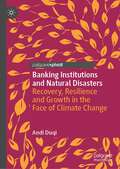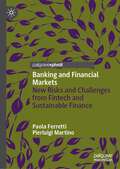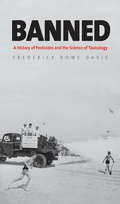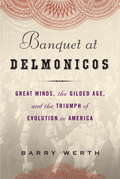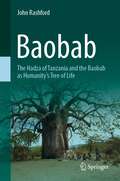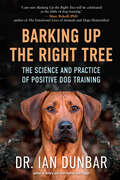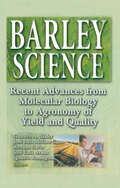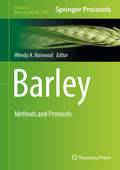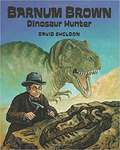- Table View
- List View
Bamboo Science and Technology (Environmental Footprints and Eco-design of Products and Processes)
by Felipe Luis Palombini Fernanda Mayara NogueiraBamboo is one of the most sustainable materials in nature due to its fast growth, rapid regeneration, outstanding mechanical properties, and applications in numerous industries. Latest technological advances have been allowing the plant to be studied and applied to exciting new projects. Being bamboo an icon of sustainable development, this book approaches the latest developments in the study of the plant, either as a natural resource or as a source of inspiration for more efficient designs. With the global urging demand for more sustainable practices, innovations in bamboo science and technology are key to the development of environmentally sound solutions.
Bamboo and Sustainable Construction (Environmental Footprints and Eco-design of Products and Processes)
by Felipe Luis Palombini Fernanda Mayara NogueiraBamboo is considered one of the most sustainable and versatile building materials, driving the development of multiple techniques for its study and utilization. With new techniques to better analyze, comprehend, and exploit its uses, the plant can be used in numerous applications. From direct building material to composites, this book explores the latest developments in the application of bamboo in the sustainable construction industry.
Bamboo: The Plant and its Uses (Tropical Forestry #10)
by Michael Köhl Walter LieseThis book presents the state-of-the-art knowledge on bamboo. It starts with an introduction to the plant's biology, its taxonomy, habitat, morphology and growth. The cultivation of bamboo is discussed in terms of silviculture, pests and diseases, and harvesting techniques. The book is completed by a comprehensive presentation of the properties of bamboo, its utilization and its preservation. Bamboo is the fastest-growing and most versatile plant on Earth. For centuries it has played an indispensible part in the daily life of millions of people in tropical countries. In recent decades it has gained increasing importance as a substitute for timber. The book was developed as a reference text for scientists, professionals, and graduate students with a strong interest in this unique plant.
Banach Contraction Principle: A Centurial Journey (Industrial and Applied Mathematics)
by Manish Jain Anita TomarThis book offers a comprehensive exploration of the Banach contraction principle and its many facets. A compilation of chapters authored by global experts, it is aimed at researchers and graduate students in mathematics. The content covers the Banach contraction principle, its generalizations, extensions, consequences and applications, focusing on both single-valued and multi-valued mappings across various spaces. While discussing theoretical foundations, this book uniquely emphasizes the practical applications of the Banach contraction principle in real-world problem-solving scenarios. Each chapter addresses specific topics, including fractals, fractional differentials, integral equations, elastic beam problems and mathematical modeling and analysis of electrical circuits. These diverse subjects showcase the principle&’s versatility in solving complex issues that go beyond theoretical mathematics. By highlighting Banach&’s contraction principle as a lasting legacy, the book not only honours past mathematical achievements but also anticipates future innovations in industrial and applied mathematics. It underscores the enduring relevance of the principle, ensuring its continued prominence in mathematical discourse and its pivotal role in driving advancements across the field. This comprehensive exploration catalyzes inspiring future developments in mathematical research.
Banana Breeding: Progress and Challenges
by Michael Pillay Abdou TenkouanoWith the current world population growth of 1.2%, the earth can expect to house 9-10 billion people by 2050. Food production, too, must increase to accommodate these numbers. Easy growing, high calorie, nutritious foods, such as bananas are the top priority as a solution to this imminent problem. The first comprehensive compendium on bananas in rec
Banana Production in Venezuela: Novel Solutions to Productivity and Plant Health (The Latin American Studies Book Series)
by Barlin Orlando Olivares CamposThis book presents an important contribution to the knowledge of the banana soils of Venezuela. Banana, the edible fruit of Musaceae, is a staple food for more than 400 million people worldwide due to their nutritional and energy attributes. This makes Musaceae a crop of worldwide relevance, particularly in tropical regions, highlighting the impact of improved Musaceae cropping systems in the current efforts worldwide oriented towards a new agricultural revolution based on sustainable intensification. To achieve this, better practices for food production based on scientific and technical research capable to consider the complexity and variability within the agri-food sector are necessary. The research presented in this book is oriented towards providing answers to the causes of two aspects considered of high relevance for banana production, both affecting productivity and sustainability, always addressed for the Venezuelan conditions, one of the world’s largest producing countries: 1- The impact of phytosanitary risks related to Fusarium Wilt (FW) and the influence of the soil on the incidence of Banana Wilt (BW); and 2- An observed trend towards loss of productivity and decline of soil quality in some commercial farms of Aragua and Trujillo states in Venezuela. The book presents a pioneering study in the application of categorical regression (CATREG) in the characterization of banana soils and analyses soil morphological variables, such as texture, dry consistency, biological activity, reaction to HCl, and type of structure to characterize soil productivity for growing healthy bananas. It develops, for the first time in Venezuela, risk analysis and climatic suitability maps for lethal wilt disease in bananas caused by Fusarium oxysporum f. sp. cubense (Foc) Tropical Race 4 (TR4) (syn. Fusarium odoratissimum). Innovative machine learning techniques are used to predict BW so that future crop development can be done more efficiently and sustainably.
Banana Ripening: Science and Technology (SpringerBriefs in Food, Health, and Nutrition)
by Anthony Keith Thompson Suriyan Supapvanich Jiraporn SirisonThe technology used to ripen bananas is affected by a wide range of factors, including the cultivar, growing conditions, harvesting method, and maturity at which the fruit are harvested and handled. Various post harvest treatments applied to fruit can also impact ripening. While many textbooks have been dedicated to Musa (bananas and plantains), none have focused exclusively on the ripening process. The commercial ripening of bananas and the chemical changes that occur thereby are considered here in detail. In developed, temperate countries where bananas are imported, successful ripening technologies have evolved. Most bananas, however, are marketed locally in the country where they are grown, and often the ripening technologies used have economic and health implications. This brief offers an in-depth discussion of not only the implications of these technologies, but also of alternative ripening methods and their commercial applications. For an understanding of both the chemical basis by which bananas ripen and the technologies used to control the process, look no further than this essential text.
Banana: Genomics and Transgenic Approaches for Genetic Improvement
by Sukhada Mohandas Kundapura V. RavishankarBananas and plantains are among the most important food and cash crops in the world. They are cultivated in more than 135 countries, across the tropics and subtropics, with an annual global production of ca. 130 million metric tonnes. Though bananas are one of the most important components of food security in many developing countries, banana production is threatened by both abiotic and biotic stresses. These include a wide range of diseases and pests, such as bunchy top virus, burrowing nematodes, black Sigatoka or black leaf streak, Fusarium wilt, etc. In recent years, considerable progress has been made and several biotechnological and genomic tools have been employed to help understand and unravel the mysterious banana genome. Molecular and genomic studies have helped to decipher the Musa genome and its evolution. Genetic linkage map and whole genome sequencing of both Musa acuminata and Musa balbisiana (progenitors of cultivated banana) have completely changed the way of thinking and the approach on banana crop improvement. Whole-genome sequencing has helped to improve the selection of quantitative traits such as yield, as well as the selection of optimal parents for developing required hybrids in breeding programs. Gene isolation and the analysis of mutants have helped in the characterization of genes of agronomic value and the associated regulatory sequences. With the advent of molecular markers and new statistical tools, it is now possible to measure the diversity, identify genes and useful alleles linked to important agronomic traits. Further these alleles can be incorporated into cultivars through marker assisted selection or through transgenic approach. Transgenic approaches are potential tools for direct transfer of these genes into popular cultivars, which are generally not amenable for conventional breeding techniques, in specific with crops such as bananas which are sterile, triploid and heterozygous thereby making it difficult to reconstruct the recurrent genotypes in banana. Transgenic techniques thus have helped overcome the difficulty of working with sterile, triploid banana crop. In the last five years, enormous amount of new information and techniques have been generated for banana. A comprehensive book entitled "Banana: Genomics and Transgenic Approaches for Genetic improvement" on banana genomics, latest transgenic technologies and tools available for improved crop development in banana will address all these requirements.
Bananas and Plantains (2nd edition)
by John C. Robinson Victor Galan SaucoThis book provides an accessible review of the scientific principles of banana production and relates these to field practices. This revised and updated edition includes expanded coverage of world trade, organic and integrated cultivation, and cultivation in greenhouses.
Band Structure of Cubic Hydrides
by Dimitrios A. PapaconstantopoulosThis book compiles detailed results of electronic structure calculations for most possible cubic monohydrides, dihydrides and selected trihydrides related to superconductivity, comprising elements with atomic numbers up to 103. Beginning with an introduction to the theory and details of the computational methods implemented, this handbook presents a collection of chapters containing results for different classes of cubic hydrides, featuring tables of three-centre and two-centre tight-binding parameterizations, diagrams of energy bands, and densities of states with angular momentum decomposition. Equilibrium lattice parameters and bulk moduli are also included, along with the electron-ion matrix element (Hopfield-McMillan parameter), Stoner criterion for ferromagnetism and values of Fermi velocities and plasmon energies. Each chapter features a brief text explaining the results presented with comparison to experimental values when available. A selection of the implemented computer codes is reproduced for the reader’s own use. This handbook is an ideal complement to any standard electronic structure text for students and researchers in materials science, condensed matter physics, and quantum chemistry.
Bangladesh II: Climate Change Impacts, Mitigation and Adaptation in Developing Countries (Springer Climate)
by Md. Nazrul Islam André van AmstelThis volume aims to develop a framework for disaster and climate risk resilient livelihood system in Bangladesh using a policy oriented approach. It highlights the possible impacts of climate change on groundwater based irrigation in the country. Climate change is one of biggest challenges to society. It can lead to serious impacts on production, life and environment on a global scale. Higher temperatures and sea level rise will cause flooding and water salinity problems which will bring about negative effects on agriculture and high risks to industry and socio-economic systems in the future. Climate change will lead to many changes in global development and security especially energy, water, food, society, job, diplomacy, culture, economy and trade. The Intergovernmental Panel on Climate Change (IPCC) defines climate change as: “Any change in climate over time, whether due to natural variability or as a result of human activity.” Global climate change has emerged as a key issue in both political and economic arenas. It is an increasingly questioned phenomenon, and progressive national governments around the world have started taking action to respond to these environmental concerns.
Banking Institutions and Natural Disasters: Recovery, Resilience and Growth in the Face of Climate Change (Palgrave Studies in Impact Finance)
by Andi DuqiThis book looks more closely at how natural disasters impact bank activity and how banks can support economic recovery after a natural disaster. The importance of banks in this context is underscored by increasing regulatory attention on their role in fostering a sustainable future, but also on the risks that climate change poses to bank stability. Humanity has tried to cope with the short- and long-term economic consequences of natural disasters for centuries. However, the severity of these events is constantly increasing in magnitude, due to the alteration of the earth’s climate and the environment. They pose a serious threat to the lives of millions of people especially in less developed countries. At the same time, the international community has acknowledged that weather hazards’ impact and countries’ resilience to them are affected by various socio-economic factors, such as the well-functioning of financial institutions, especially commercial banks. Banks will inevitably adapt their strategies to address concerns arising from climate change. In doing this, the book discusses partnerships with international cooperation institutions, other financial intermediaries, and local governments, so that the green transition ensures an inclusive growth for all, especially the most vulnerable parts of our societies. This book is of interest to researchers, academics, and students of sustainable finance and climate finance.
Banking and Financial Markets: New Risks and Challenges from Fintech and Sustainable Finance
by Paola Ferretti Pierluigi MartinoThis book provides the foundational knowledge essential for comprehending the functioning of financial markets and institutions and their current challenges. First, the book provides a general overview on the functioning of the EU financial system, examining financial markets and financial intermediaries’ features and activity and their contribution to economic growth. It also outlines the evolution of the EU integration process, giving an overview of the most important regulatory steps related to the banking and financial system culminated in the creation of the Banking Union. Banking activity is also examined in the most important business areas: commercial versus investment banking. Lastly, the book introduces two important phenomena, which are currently characterizing the financial environment: FinTech and sustainable finance. Both FinTech and sustainable finance represent significant opportunities for the market and the operators, even if the challenges and risks associated are also relevant. This underlines the need to understand their intensity and their potential impact on the functioning of the financial system as a whole.
Banking on the Body
by Kara W. SwansonScientific advances and economic forces have converged to create something unthinkable for much of human history: a robust market in human body products. Every year, countless Americans supply blood, sperm, and breast milk to "banks" that store these products for later use by strangers in routine medical procedures. These exchanges entail complicated questions. Which body products are donated and which sold? Who gives and who receives? And, in the end, who profits? In this eye-opening study, Kara Swanson traces the history of body banks from the nineteenth-century experiments that discovered therapeutic uses for body products to twenty-first-century websites that facilitate a thriving global exchange. More than a metaphor, the "bank" has shaped ongoing controversies over body products as either marketable commodities or gifts donated to help others. A physician, Dr. Bernard Fantus, proposed a "bank" in 1937 to make blood available to all patients. Yet the bank metaphor labeled blood as something to be commercially bought and sold, not communally shared. As blood banks became a fixture of medicine after World War II, American doctors made them a frontline in their war against socialized medicine. The profit-making connotations of the "bank" reinforced a market-based understanding of supply and distribution, with unexpected consequences for all body products, from human eggs to kidneys. Ultimately, the bank metaphor straitjacketed legal codes and reinforced inequalities in medical care. By exploring its past, Banking on the Body charts the path to a more efficient and less exploitative distribution of the human body's life-giving potential.
Banned
by Frederick Rowe DavisRachel Carson’s eloquent book Silent Spring stands as one of the most important books of the twentieth century and inspired important and long-lasting changes in environmental science and government policy. Frederick Rowe Davis thoughtfully sets Carson’s study in the context of the twentieth century, reconsiders her achievement, and analyzes its legacy in light of toxic chemical use and regulation today. Davis examines the history of pesticide development alongside the evolution of the science of toxicology and tracks legislation governing exposure to chemicals across the twentieth century. He affirms the brilliance of Carson’s careful scientific interpretations drawing on data from university and government toxicologists. Although Silent Spring instigated legislation that successfully terminated DDT use, other warnings were ignored. Ironically, we replaced one poison with even more toxic ones. Davis concludes that we urgently need new thinking about how we evaluate and regulate pesticides in accounting for their ecological and human toll.
Banquet at Delmonico's
by Barry WerthIn Banquet at Delmonico's, Barry Werth, the acclaimed author of The Scarlet Professor, draws readers inside the circle of philosophers, scientists, politicians, businessmen, clergymen, and scholars who brought Charles Darwin's controversial ideas to America in the crucial years after the Civil War.The United States in the 1870s and '80s was deep in turmoil-a brash young nation torn by a great depression, mired in scandal and corruption, rocked by crises in government, violently conflicted over science and race, and fired up by spiritual and sexual upheavals. Secularism was rising, most notably in academia. Evolution-and its catchphrase, "survival of the fittest"-animated and guided this Gilded Age.Darwin's theory of natural selection was extended to society and morals not by Darwin himself but by the English philosopher Herbert Spencer, father of "the Law of Equal Freedom," which holds that "every man is free to do that which he wills," provided it doesn't infringe on the equal freedom of others. As this justification took root as a social, economic, and ethical doctrine, Spencer won numerous influential American disciples and allies, including industrialist Andrew Carnegie, clergyman Henry Ward Beecher, and political reformer Carl Schurz. Churches, campuses, and newspapers convulsed with debate over the proper role of government in regulating Americans' behavior, this country's place among nations, and, most explosively, the question of God's existence.In late 1882, most of the main figures who brought about and popularized these developments gathered at Delmonico's, New York's most venerable restaurant, in an exclusive farewell dinner to honor Spencer and to toast the social applications of the theory of evolution. It was a historic celebration from which the repercussions still ripple throughout our society.Banquet at Delmonico's is social history at its finest, richest, and most appetizing, a brilliant narrative bristling with personal intrigue, tantalizing insights, and greater truths about American life and culture.From the Hardcover edition.
Baobab: The Hadza of Tanzania and the Baobab as Humanity's Tree of Life
by John RashfordModern humans, descendants of a founding population that separated from chimpanzees some five to eight million years ago, are today the only living representative of a branching group of African apes called hominins. Because of its extraordinary size and shape, the baobab (Adansonia digitata L.) has long been identified as the most striking tree of Africa’s mosaic savanna, the landscape generally regarded as the environment of hominin evolution. This book makes the case for identifying the baobab as the tree of life in the hunter-gatherer adaptation that was the economic foundation of hominin evolution. The argument is based on the significance of the baobab as a resource-rich environment for the Hadza of northeastern Tanzania, who continue to be successful hunter-gatherers of the African savanna.
Barbaren, Geister, Gotteskrieger: Die Evolution der Religionen – entschlüsselt
by Ina WunnEin neuer Blick auf die Entwicklung der Religionen In diesem Buch geht es um die Evolution der Religionen, also um die Frage, wie und warum sich Religionen im Laufe ihrer geschichtlichen Entwicklung ver#65533;ndern und welche Gesetzm#65533;#65533;igkeiten diesen Ver#65533;nderungen zugrunde liegen. Die Autorin schildert zun#65533;chst, wie der Evolutionsgedanke sowohl in der Biologie als auch in den Geisteswissenschaften Fu#65533; gefasst hat. Dies war eine Zeit eigenwilliger Protagonisten und spannender Kontroversen, die lebhaft vor das Auge des Lesers treten. Das Buch geht dann der Frage nach, was Evolution im Bereich der Religion eigentlich bedeutet und welche Faktoren diese religi#65533;se Evolution steuern. Welcher Anpassungswert kommt Religionen zu? Wie spalten sich Religionen auf und entwickeln sich in zunehmender Eigenst#65533;ndigkeit? Gibt es so etwas wie eine Vererbung, eine Stammesgeschichte und eine Systematik der Religionen, #65533;hnlich des Gedankengeb#65533;udes, das die biologische Evolutionstheorie f#65533;r die Entwicklung der Organismenwelt entworfen hat? Am Ende dieses mutigen Buches steht nicht nur eine belastbare Theorie religi#65533;ser Evolution, sondern es wird auch deutlich, welche Umwelt- und sozialen Faktoren die Entwicklung von Religionen heute steuern. In einer Welt, in der das Religi#65533;se mit Macht zur#65533;ckzukehren scheint, d#65533;rfte dieses Werk auch zu einem differenzierteren Blick auf die Vielfalt und Einheit der Religionen beitragen. Die Autorin Ina Wunn ist Professorin f#65533;r Religionswissenschaft an der Leibniz-Universit#65533;t Hannover. Das besondere Interesse der Biologin und Religionswissenschaftlerin gilt dem Ursprung und der Evolution der Religionen.
Barbie: The Class Act
by Rita BalducciBeing the new kid isn't easy. But Jane has Barbie as her fifth-grade teacher. With Barbie's help, Jane and her classmates work together on a science fair project that gets the whole class hopping!
Barking Up the Right Tree: The Science and Practice of Positive Dog Training
by Ian Dunbar“I am sure Barking Up the Right Tree will be celebrated as the bible of dog training.” — Marc Bekoff, PhD, author of The Emotional Lives of Animals and Dogs Demystified When Dr. Ian Dunbar introduced his SIRIUS® Puppy Training in 1982, dog training mostly comprised punishing adult dogs for bad habits and lack of compliance. Dunbar focused on verbally cuing and creatively luring to achieve desirable behavior and using “life rewards” — sniffing, walking, play with dogs, and interactive games — to reinforce speedy compliance and good habits from the outset. His “dog’s point of view” approach revolutionized the field, and today there are few trainers who have not been strongly influenced by it. While positive reinforcement is now widely adopted, this new book details how other reward-training techniques have strayed from Dunbar’s original, quick and easy, highly effective lure-reward approach for teaching dogs ESL, in which we can verbally cue specific responses, offer heartfelt praise for success, and give guidance when dogs err. With Dunbar’s method, we can teach dogs when and where to eliminate, what to chew, when and for how long to bark, and when and how to appropriately let off steam. Barking Up the Right Tree offers proof that aversive punishment seldom works to eliminate undesirable behavior or to get the dog back on track. Dunbar presents numerous nonaversive yet highly effective solutions for misbehavior and noncompliance — simply by using the words you teach, and without even raising your voice. The culmination of fifty-plus years at the vanguard of dog behavioral science, Barking Up the Right Tree is an indispensable guide for anyone who wants harmonious, two-way communication with a calm, confident, well-behaved, happy canine companion.
Barley Science: Recent Advances from Molecular Biology to Agronomy of Yield and Quality
by Roxana Savin Gustavo A Slafer Jose Luis Molina-Cano Jose Luis Araus Ignacio RomagosaFind up-to-date information on barley for malting, food, and animal feed!This comprehensive book covers every aspect of barley from molecular biology to agronomy of yield and quality. In addition to the exposition of the basic concepts, Barley Science explains the latest developments in the field. In addition, this remarkable book presents ideas and techniques for bridging the gap between physiology and breeding. Beginning with the history of this ancient cultivated grain, Barley Science presents state-of-the-art information on genetics and breeding, physiology, and agronomy. One chapter explains the CERES computer simulation of barley growth, development, and yield. Every chapter includes a thorough literature review, and you will find many helpful tables and figures.Barley Science offers cutting-edge information on the latest developments in the field, including: wild barley as a source of genes for crop improvement genetics and breeding for specific attributes genetic engineering determining barley yield under stress new breeding strategies for disease resistance choosing genotype, sowing date, and plant density for malting barley enhancing pre-harvest sprouting resistance barley proteins and malting performance Written by the top experts in the field, Barley Science is an excellent update and broadening of the information found in previous barley books. Agronomists, breeders, geneticists, and physiologists--and their students--will turn again and again to this essential resource.
Barley: Methods and Protocols (Methods in Molecular Biology #1900)
by Wendy A. HarwoodThis detailed volume explores barley as both a crop and a model, with practical techniques such as crossing barley, a range of tissue culture methods, the preparation of barley tissues for different forms of microscopy, and the assessment of sensitivity to abiotic stresses. Efficient protocols are provided for transformation, TILLING, virus-induced gene silencing and genome editing. There is also particular emphasis on a range of protocols for genotyping and for the analysis of gene expression. Written for the highly successful Methods in Molecular Biology series, chapters include introductions on their respective topics, lists of the necessary materials and reagents, step-by-step, readily reproducible laboratory protocols, and tips on troubleshooting and avoiding known pitfalls. Authoritative and easy-to-use, Barley: Methods and Protocols serves as a valuable reference volume for cereal researchers and breeders by providing detailed protocols covering important traditional skills such as crossing and tissue culture through to the latest technologies for genotyping, expression analysis, and genome editing.
Barnacle Biology (Crustacean Issues Ser.)
by Alan J. SouthwardThis text gives an overview of almost all aspects of barnacle biology covering advances made since Charles Darwin to the present day.
Barney and the UFO
by Margaret Goff ClarkBarney is afraid to tell his foster parents that he has seen a UFO behind the house even when a hasty promise to a space boy leads him into trouble.
Barnum Brown: Dinosaur Hunter
by David Sheldon<p>Barnum Brown had one ambition as a child: to grow up to be a great dinosaur hunter. And that's just what he did when he was hired by the American Natural History Museum―working to build their astounding collection. Barnum had a knack for finding dinosaur bones, a skill that rivaled the paleontologists before him. His most amazing discovery was uncovering the largest carnivore that ever walked the earth: the "tyrant lizard king," Tyrannosaurus Rex! <p>Dig into the life of the greatest dinosaur hunter of all time with this exciting biography of Barnum Brown―the best noses in the business for sniffing out dinosaur bones.</p>
